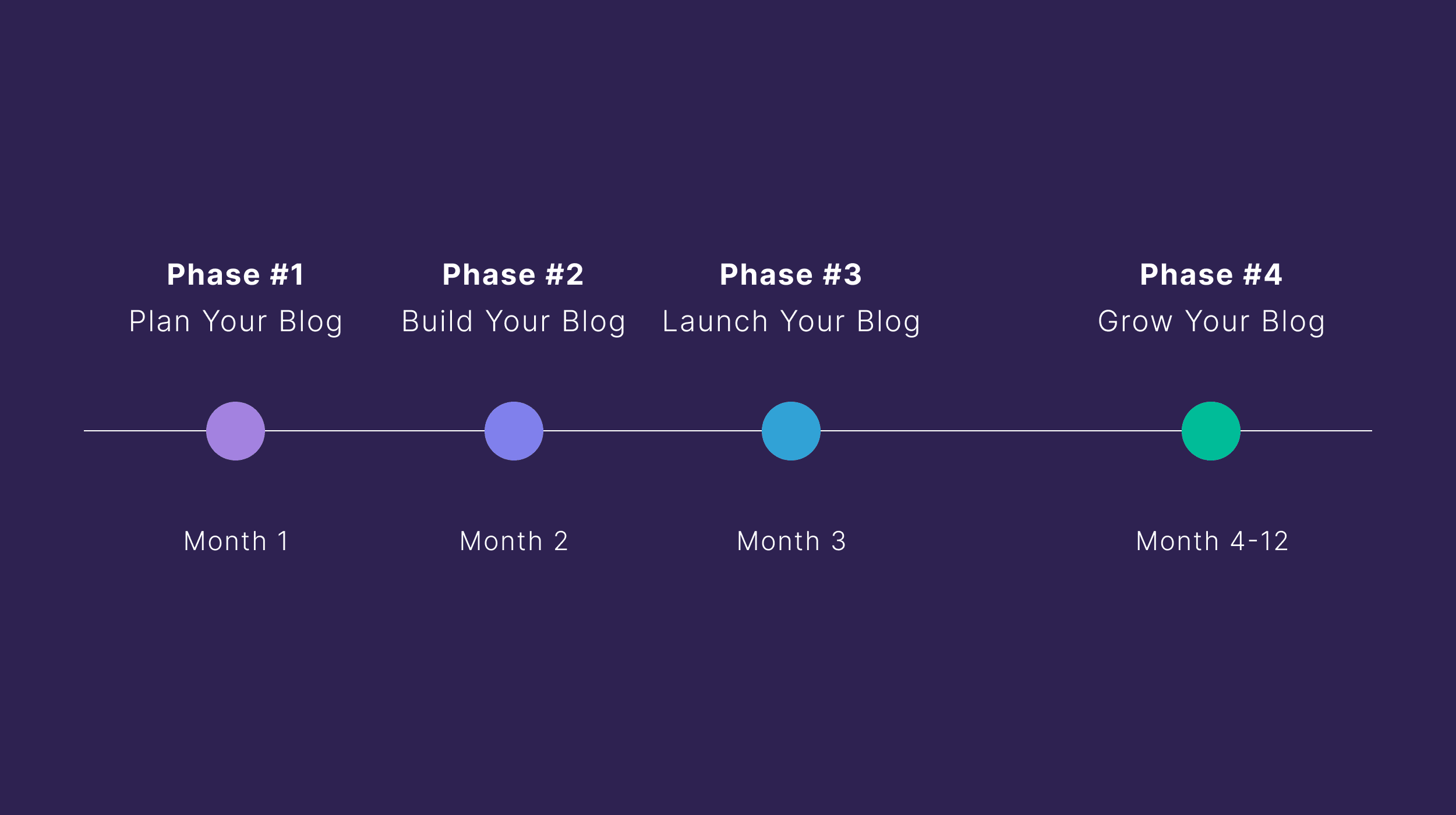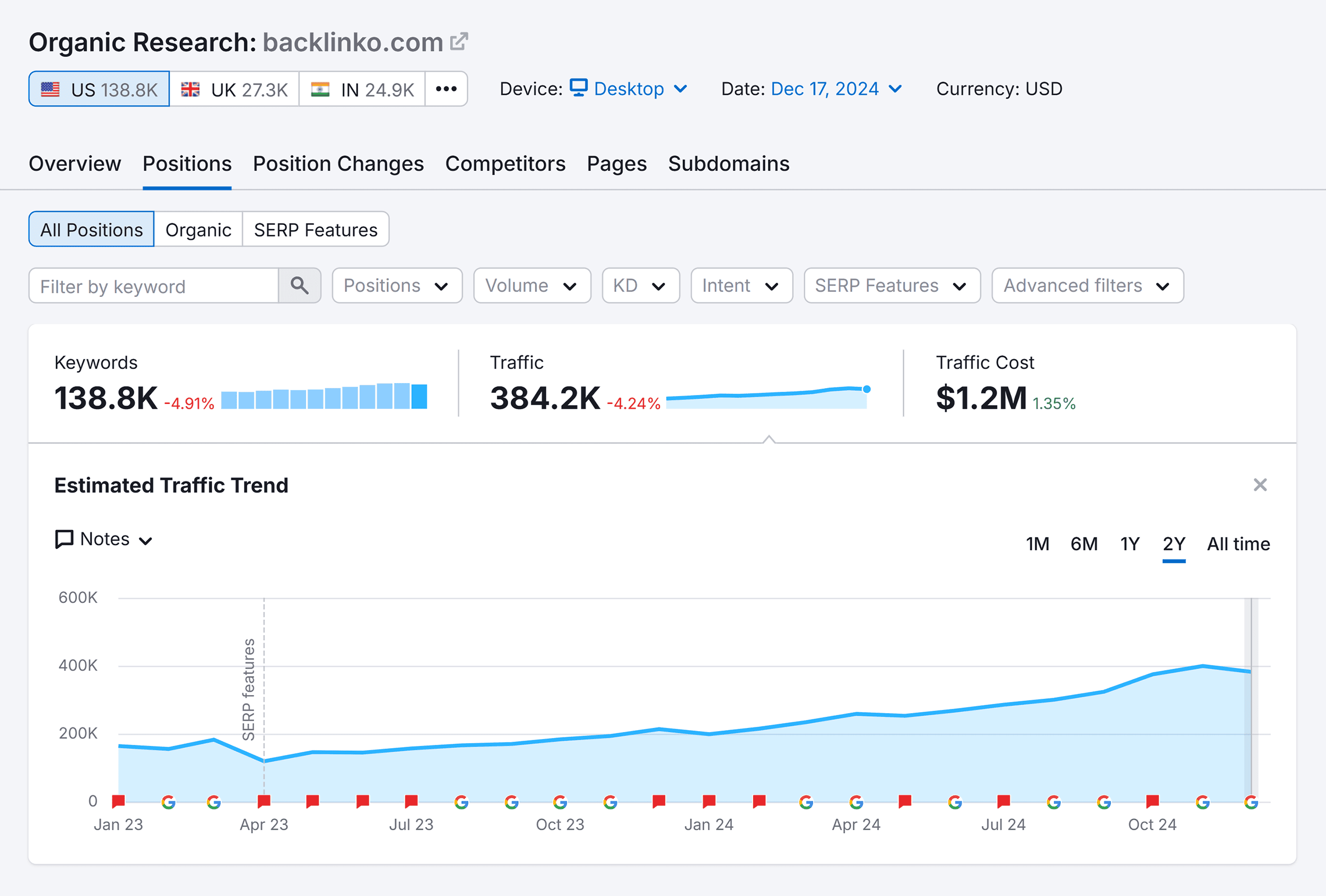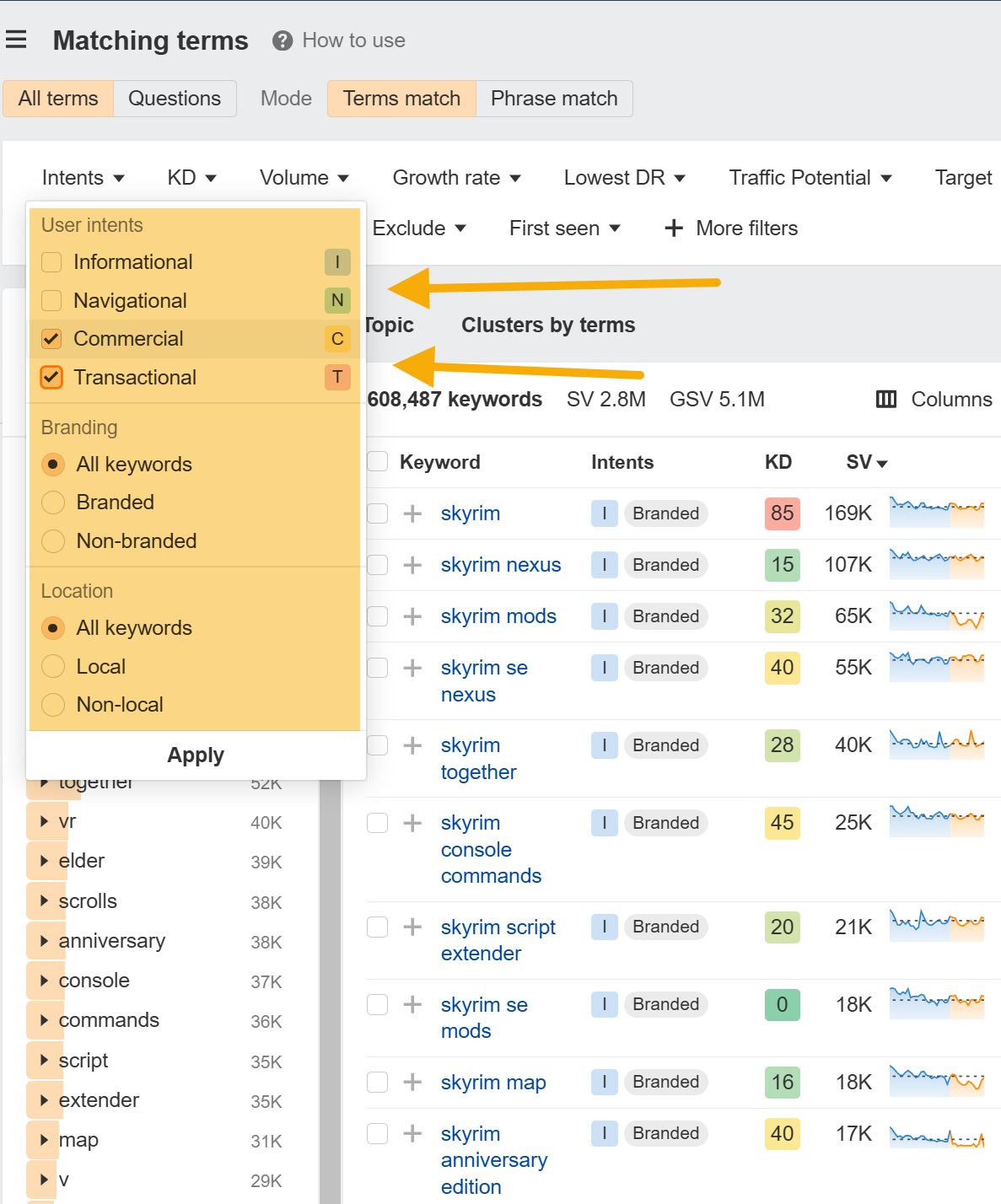If you have a website, keyword mapping should be a priority.
Why?
Because it can help you get more visitors, leads, and conversions. Noticeably more.
At Backlinko, keyword mapping helps us reach 500k+ organic sessions every month.
In this step-by-step guide, you’ll find everything you need to get started with keyword mapping.
Plus, a free keyword mapping template.
But first, let’s start with the basics.
What Is Keyword Mapping?
Keyword mapping is the process of organizing target keywords into groups and assigning them to specific pages on your website.
And creating a detailed keyword map to keep track of important details. Including keyword volume, difficulty, and more.
Like this:

Why not just scribble it all down on a napkin?
Creating a detailed keyword map ensures you have a permanent, organized document to guide your SEO strategy. Which helps keep you consistent in your optimization efforts.
And gives your website content a serious advantage on search engine results pages (SERPs).
Benefits of Keyword Mapping
Not sure keyword mapping is worth the effort? Here’s a look at the benefits it can provide:
- Improves the site experience for visitors and search engines
- Reduces bounce rates
- Creates a path for search engines to follow
- Builds a strong internal linking system
- Helps avoid keyword cannibalization
- Identifies keyword gaps
At Backlinko, we use keyword mapping to avoid cannibalization and ensure a strong internal link network. This allows our users to easily find information on any core topic.
Keyword mapping helps us think strategically about our ideal customers and how to design our website to best meet their needs.

Leigh McKenzie, head of SEO at Backlinko, said:
How to Do Keyword Mapping in 5 Steps
1. Download Our Free Keyword Mapping Template
Ready to learn how to create a keyword map? Download our free keyword mapping template to follow along with our step-by-step tutorial below.
Once you’ve downloaded the template, rename it in the upper left.

Here’s a peek at some of the terminology and columns in the template:
- Pillar pages: A list of your site’s pillar page keywords
- Cluster topics: A list of subtopic keywords
- Volume: The average monthly searches for each primary keyword
- KD (keyword difficulty) score: The estimated difficulty level of each primary keyword
- Keyword variations: Groups of keywords you can use as secondary keywords
- Total volume: The combined potential traffic of primary keywords and keyword variations
- Target URL: The site page you assign to each group of keywords
- Status: A drop-down selection that indicates the page’s status
- Last updated: A record of the last time you optimized the page for its current keywords
2. Find Keywords for Mapping
Before using the keyword mapping template, you’ll need to create three keyword lists:
- Pillar page keywords
- Cluster topic keywords
- Keyword variations
Start by choosing one of your blog’s main topics.
For example, if your blog’s niche is gardening, you might choose a main topic like “gardening tools” or “gardening tips.”
Got it?
Now you’re ready to dive into keyword research and build your lists.
Pillar Page Keywords
Pillar page keywords represent your site’s main topics. You’ll assign them to your site’s pillar pages.
Use a keyword research tool like Semrush’s Keyword Magic or Google Keyword Planner to identify keywords that match your site’s main topic.
For this example, we used the Keyword Magic Tool.
Enter your main site topic into the search bar and click “Search.” We used “gardening tips.”
Enter your site’s URL into the purple search bar for personalized data (including a keyword difficulty score tailored to your domain).

Scroll down to view the results.
Then, select the keyword you think is the best match for your pillar page topic.
Our “gardening tips” search turned up keywords like “beginner gardening tips” and “vegetable gardening tips.”

These might make great cluster topic keywords. Or they might work for a different pillar page down the road.
But they’re not as great for a pillar page on “gardening tips.”
Because we want a keyword that describes our main topic perfectly.
We’re in luck.
There’s an exact match, “gardening tips,” at the top of the keyword results page.
The estimated monthly search volume is 1,600, which is a good amount of traffic.
The keyword difficulty score is rated as “difficult,” meaning we’ll need many referring domains and optimized content to help this page rank. For our example site, this is attainable.

Next, we’ll check the keyword’s search intent. Search intent, sometimes called “user intent,” is the reason behind a person’s search.
And it’s a big deal in keyword mapping.
Matching keywords with the correct search intent makes it easier for Google to index your pages correctly.
Which can ultimately result in more traffic to your website. It also helps searchers find the type of content they’re looking for, reducing bounce rate.
The most common types of search intent are:
- Informational: The searcher is looking for information on a topic. Like “gardening tips” or “how to start a rose garden.”
- Navigational: The searcher is looking for a specific website. Such as “MyGardeningTips” or “Amazon.”
- Commercial: The searcher is checking out products or services. For example, “gardening tools under $10.”
- Transactional: The searcher is actively looking to make a purchase. Like “buy gardening gloves.”
Check the “Intent” column next to the keyword in the Keyword Magic Tool.

“I” indicates “informational” search intent, “C” indicates “commercial,” and so on.
Our “gardening tips” keyword has both an “informational” and “commercial” intent. But what’s most important is the “informational” intent.
Since we’re creating an ultimate guide, this intent works well. Informational blog content like how-to guides, tips, and listicles is almost always a good match for “informational” search intent.
Once you’ve decided on your keyword, save it to a keyword list in Semrush.
Check the box next to the keyword(s) you want to save. Click “+ Add to list.”

Click “Create new empty list” and give your keyword list a name. We named ours “Pillar page keywords.”
Repeat this process for the other two lists you’ll build next (“Keyword variations” and “Cluster topic keywords).
Cluster Topic Keywords
Cluster topic keywords represent subtopics of your pillar pages. Each cluster topic page you create will link to its main pillar page. And the pillar page will link back to the cluster.
This creates a strong, topic-driven internal linking strategy.
You can find popular subtopic ideas using your initial keyword research.
For example, our main keyword was “gardening tips.” Which turned up a handful of great subtopic ideas.
Like “raised bed gardening tips” and “spring gardening tips.”

Long-tail keywords, like the two above, work well for cluster posts.
Why?
Because long-tail keywords are highly specific terms that tend to have lower keyword difficulty scores.
Add the subtopic keywords to your “Cluster topic keywords” lists in Keyword Magic.
Keyword Variations
Keyword variations are phrases that have similar meanings to the original keyword.
Including different keyword variations increases the chances of capturing a wider audience who might phrase their searches differently.
It can also improve your website’s visibility on SERPs by covering more search queries and increasing your chances of ranking for related terms.
Find keyword variations by looking at your search results in Keyword Magic Tool.
For example, “tips on gardening,” “gardening tips and tricks,” and “tips for gardening” appeared in our original search for “gardening tips.”

Add the variations to your “Keyword variations” list.
3. Add the Keywords to Your Map
If you haven’t already, download our free keyword mapping template.
Now, open your keyword mapping template and add your pillar page keywords to column “A.” Add monthly search volumes to column “C” and KD scores to column “D.”
When you’re finished, it should look like this:

Next, enter your cluster topic keywords in column “B,” alongside their volume in column “C” and KD scores in column “D.”
Like this:

Next, add your keyword variations to the map. Enter these in column “E” as a group.
Add search volume in parentheses behind each keyword.
Like this: “tips on gardening (210), gardening tips and tricks (170).”
No KD% score needed.
Here’s what it looks like in the keyword map:

Next, get out your calculator to tally up the total search volume for each row.
Why?
Recording the total search volume provides a comprehensive view of potential traffic, helping you prioritize high-impact content. This strategy also ensures you focus on keywords that drive the most value, enhancing your SEO efforts.
And maximizing your website’s visibility and engagement.
For each row:
- Add the primary keyword Volume (column C) + the total volume of all Keyword Variations (column E).
- Record your answer in Column F, “Total Volume.”
For our example, our Total Volume for this row is 2,150

4. Match Keywords to Pages
In this step, we’ll match each row of keywords to an existing or future page on your site.
Let’s start with the first row.
In this example, the first row contains the primary keyword “gardening tips.”
If you already have a published piece of content that matches the primary keyword, add its URL to column “G.”
Like this:

Don’t you have a piece of content that matches the primary keyword? Leave column “G” blank.
Next, move to column “H” and select a status from the drop-down menu.

Which status should you choose?
- To Create: If you haven’t published content for the primary keyword yet
- To Optimize: If you’ve published content for this topic but haven’t fully optimized it for the primary and secondary keywords in this map
- Updated: If you’ve published content for this keyword AND it is fully updated according to the primary and secondary keywords in this map
The next and final step is column “I,” “Last Updated.”
This column only applies if you have an active URL entered in column “G.”
Otherwise, leave it blank.
Use this space to note when you last optimized this post for the keywords in your map. If you haven’t optimized or created it yet, leave it blank.
Repeat the process for each row in the template.
It should look something like this:

Congrats! You’ve just completed your keyword map.
Now what?
Use your completed keyword map to optimize website content and plan new content.
We will show you how in the final step below.
5. Use Your Keyword Map to Optimize Website Pages
Start with your existing site pages, if you have any.
For example, let’s say you already have a pillar page called “The Ultimate Guide to Gardening Tips.”
Its keywords are:
- Primary keyword: Gardening Tips
- Keyword variations: tips on gardening, gardening tips and tricks, tips for gardening

To optimize the pillar page so it aligns with your keyword map, use the primary keyword in your:
- Title tag
- Meta description
- Introduction (first 100 words)
- Subheaders when relevant
- Throughout the text, naturally
- Image alt text, when appropriate
Add each of the secondary keywords (keyword variations) at least once within the blog post.

Apply the same techniques when creating new pillar pages and cluster posts.
Update the “Status” and “Last Updated” columns in your keyword mapping template each time you optimize or create another page.
Your completed map also shows where you have content gaps.
Any row without an existing “Target URL” in column G is a gap you’ll want to fill with new content.
Your new keyword map will help you plan what content to add or update next. And ensure that you don’t miss out on or duplicate any site keywords.
SEO Tools for Keyword Mapping
Free Keyword Mapping Tools
Some of the most popular free keyword mapping tools include:
- Google Keyword Planner: For initial keyword research and discovery
- Semrush’s keyword tools: For identifying pillar and cluster keywords (search up to 10 terms per day for free in Keyword Magic Tool and Keyword Overview)
- Ahrefs Keyword Difficulty Checker: Another great option for finding keywords
- Google Search: For brainstorming topic and subtopic ideas
For example, Google Keyword Planner is free to use. It can help you find new topic ideas related to your main keyword.
Go to: “Google Ads” > “Solutions” > “Keyword Planner” and enter a keyword. Then, click “Get Results.”
Like we did with “gardening tips.”

Our gardening tips keyword produced new subtopics we hadn’t thought of before.
Like “backyard decor ideas,” “composting tips,” and “cheap container gardening ideas.”

While this can be a great way to research new terms, Google only shows a range for monthly search volume—unless you’re actively using Google Ads and hitting an undisclosed monthly spending requirement.
If you find keywords with potential, drop them into the Keyword Overview to see a more precise estimation.

Paid Keyword Mapping Tools
Need more in-depth insights?
A paid SEO tool like Semrush, Ahrefs, or Surfer SEO may be worth the investment.
Semrush
While many of Semrush’s tools have free, limited access, a paid subscription offers even more features and tools.
For example, Semrush’s Keyword Strategy Builder tool simplifies and automates the keyword mapping process.
Here’s how:
Enter your site’s main keyword and click “Create list.”
Like we did here with the “gardening tips” keyword.

When your report is ready, you’ll have a full, customized strategy built around your keyword. Including a list of suggested pillar page and cluster topic keywords.

For the keyword “gardening tips,” it gave us ideas like “vegetable gardening” and “rose plant” as pillar pages.
And suggested cluster topics such as “Hanging basket flowers” and “water hose.”
Earlier, we were thinking that the keyword “vegetable gardening” would make a good cluster topic keyword. But this strategy suggests using the keyword for a pillar page.
And that’s not a bad idea. So, we’ll give it some thought.
Scroll down the page for even more pillar and cluster keyword suggestions.

Ahrefs
Ahrefs is a comprehensive suite of SEO tools that can help you with keyword mapping.
For example, drop a keyword into its Keywords Explorer tool, and it’ll generate thousands of ideas. It’ll also automatically cluster keywords, helping speed up your keyword mapping efforts.

Surfer’s Topic Explorer
Surfer SEO’s Topic Explorer helps you analyze site topics and provides suggestions for supporting cluster pieces. It can also show you what topic clusters your competition covers.

Enter a keyword, and the tool will generate a map with subtopics. We entered “gardening tips,” and it suggested additional pillar page ideas (called Topics), such as “Home Gardening” and “Planting Guide.”
It also provides keyword ideas, along with the keyword difficulty and search volume for each term.
Getting Started with Keyword Mapping
Keyword mapping is one of the smartest SEO moves you can make.
It helps you think strategically about every topic, keyword, and page on your site. Boosting rankings and the user experience in the process.
But keyword mapping is just the start.
You’ll need a comprehensive SEO strategy to drive year-round organic traffic.
In our SEO Strategy Guide, learn how to analyze SERP results and create content that outranks your competitors.
Content Copyrights Belong to The Author. All Rights Reserved.
We're A Dallas Digital Marketing Agency That is Experts At Social Media Marketing, Website Design and Emarketing and Promotion.




